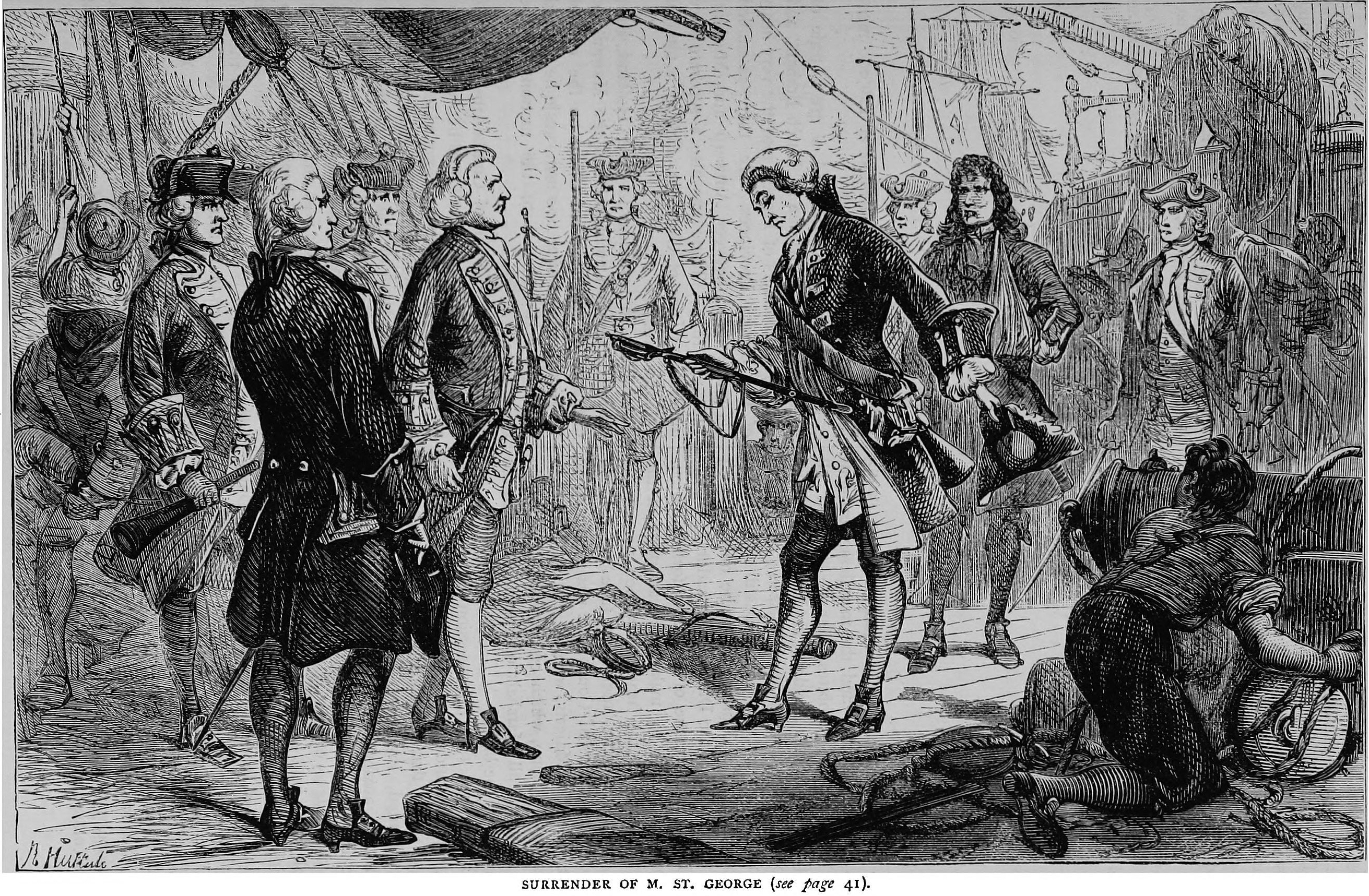HMS Prince George (1701) on:
[Wikipedia]
[Google]
[Amazon]
HMS ''Duke'' was a 90-gun  She underwent a rebuild in 1701 as another 90-gun second rate, and was renamed HMS ''Prince George'' (after the future
She underwent a rebuild in 1701 as another 90-gun second rate, and was renamed HMS ''Prince George'' (after the future 
 In June 1757 ''Prince George'' was taken into Portsmouth Dockyard for repairs. The work took four months to complete at a total cost of £9,513, after which the ship was recommissioned as the flagship of Rear Admiral Broderick. On 13 April 1758, ''Prince George'' was at sea in the
In June 1757 ''Prince George'' was taken into Portsmouth Dockyard for repairs. The work took four months to complete at a total cost of £9,513, after which the ship was recommissioned as the flagship of Rear Admiral Broderick. On 13 April 1758, ''Prince George'' was at sea in the
second-rate
In the rating system of the Royal Navy used to categorise sailing warships, a second-rate was a ship of the line which by the start of the 18th century mounted 90 to 98 guns on three gun decks; earlier 17th-century second rates had fewer guns ...
ship of the line
A ship of the line was a type of naval warship constructed during the Age of Sail from the 17th century to the mid-19th century. The ship of the line was designed for the naval tactic known as the line of battle, which depended on the two colu ...
of the Royal Navy
The Royal Navy (RN) is the United Kingdom's naval warfare force. Although warships were used by English and Scottish kings from the early medieval period, the first major maritime engagements were fought in the Hundred Years' War against F ...
, launched on 13 June 1682 at Woolwich Dockyard
Woolwich Dockyard (formally H.M. Dockyard, Woolwich, also known as The King's Yard, Woolwich) was an English Royal Navy Dockyard, naval dockyard along the river Thames at Woolwich in north-west Kent, where many ships were built from the early 1 ...
.
 She underwent a rebuild in 1701 as another 90-gun second rate, and was renamed HMS ''Prince George'' (after the future
She underwent a rebuild in 1701 as another 90-gun second rate, and was renamed HMS ''Prince George'' (after the future George II George II or 2 may refer to:
People
* George II of Antioch (seventh century AD)
* George II of Armenia (late ninth century)
* George II of Abkhazia (916–960)
* Patriarch George II of Alexandria (1021–1051)
* George II of Georgia (1072–1089)
* ...
). After her rebuild, she served in the War of the Spanish Succession
The War of the Spanish Succession was a European great power conflict that took place from 1701 to 1714. The death of childless Charles II of Spain in November 1700 led to a struggle for control of the Spanish Empire between his heirs, Phil ...
, fighting in the Battle of Málaga and the capture of Gibraltar
)
, anthem = " God Save the King"
, song = " Gibraltar Anthem"
, image_map = Gibraltar location in Europe.svg
, map_alt = Location of Gibraltar in Europe
, map_caption = United Kingdom shown in pale green
, mapsize =
, image_map2 = Gib ...
.
On 4 November 1719 ''Prince George'' was ordered to be taken to pieces and rebuilt at Deptford
Deptford is an area on the south bank of the River Thames in southeast London, within the London Borough of Lewisham. It is named after a ford of the River Ravensbourne. From the mid 16th century to the late 19th it was home to Deptford Dock ...
by Richard Stacey
Richard Stacey (1663–1743) was an English shipbuilder and ship designer employed by the Royal Navy
The Royal Navy (RN) is the United Kingdom's naval warfare force. Although warships were used by English and Scottish kings from the ...
, and she was relaunched on 4 September 1723 as a 90-gun second-rate built to the 1719 Establishment
The 1719 Establishment was a set of mandatory requirements governing the construction of all Royal Navy warships capable of carrying more than 20 naval long guns. It was designed to bring economies of scale through uniform vessel design, and ens ...
.

 In June 1757 ''Prince George'' was taken into Portsmouth Dockyard for repairs. The work took four months to complete at a total cost of £9,513, after which the ship was recommissioned as the flagship of Rear Admiral Broderick. On 13 April 1758, ''Prince George'' was at sea in the
In June 1757 ''Prince George'' was taken into Portsmouth Dockyard for repairs. The work took four months to complete at a total cost of £9,513, after which the ship was recommissioned as the flagship of Rear Admiral Broderick. On 13 April 1758, ''Prince George'' was at sea in the Bay of Biscay
The Bay of Biscay (), known in Spain as the Gulf of Biscay ( es, Golfo de Vizcaya, eu, Bizkaiko Golkoa), and in France and some border regions as the Gulf of Gascony (french: Golfe de Gascogne, oc, Golf de Gasconha, br, Pleg-mor Gwaskogn), ...
when a fire broke out below decks. The flames quickly spread throughout the ship and she foundered with the loss of 485 out of 745 crew.Winfield 2007, pp. 13-14
Notes
References
*Lavery, Brian (2003) ''The Ship of the Line - Volume 1: The development of the battlefleet 1650-1850.'' Conway Maritime Press. . *External links
* Ships of the line of the Royal Navy 1680s ships {{UK-line-ship-stub